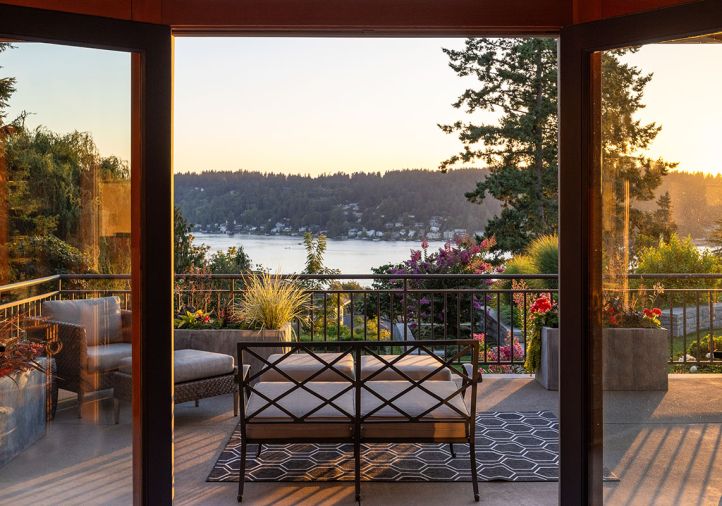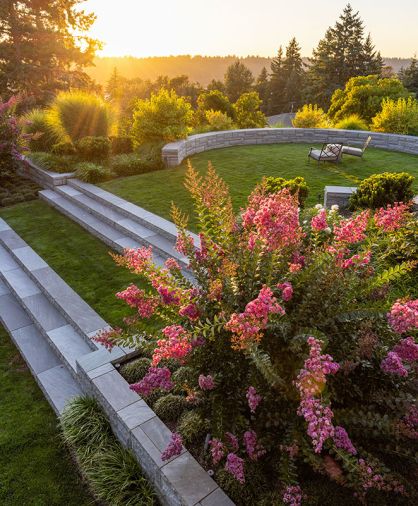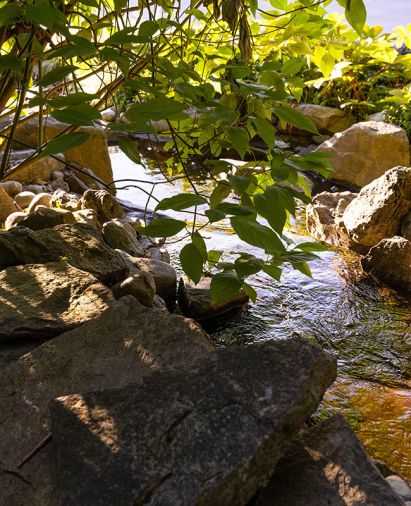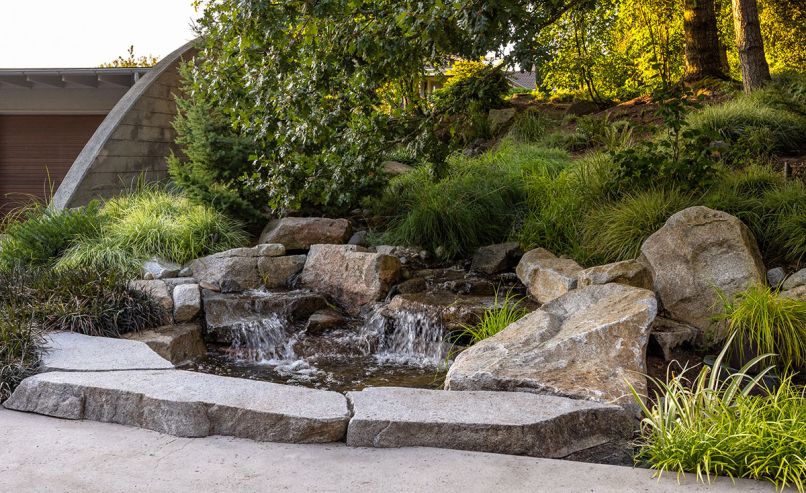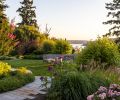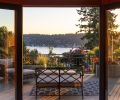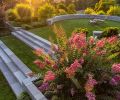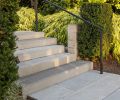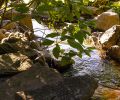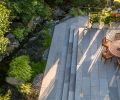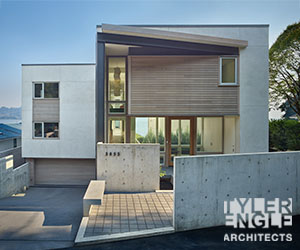Tina Scoccolo has spent 58 years enjoying views of Lake Washington – first when growing up from her parents’ home, then from the adjacent 1997 home she built with her husband Kevin Steiner who became a partner in her former commercial landscape construction company of 35 years. Scoccolo was keen to find a landscape architect who could transform her very mature, overgrown garden into something that spoke of her family’s Italian heritage. After interviewing three landscape architecture companies, she knew Scott Holsapple of SHD Landscape Architecture was the clear choice. “Primarily because his understanding of garden design went beyond recommending plants,” recalls Scoccolo. “Not only does he understand grading, hydrology, irrigation, hardscape, drainage, erosion control and materials, but he is also congenial with an affable personality – making him someone I knew I could work with.”
Ironically, the homeowner was unaware at the time that Holsapple had studied landscape architecture in Rome as a young man, giving him yet another edge in his understanding of contemporary Italianate features such as rounded spaces, flowing water features, natural materials, hillside terraces and symmetrical pathways; all of which he included in his initial image board. “Tina and Kevin were very special clients,” says Holsapple, “who trusted in our ability to distill their vision as well as our understanding of the process and how to get it implemented - which without exception ends up with a good final outcome.”
What Scoccolo didn’t like about her old garden were the small, shady, cave-like spaces and strange transitions that didn’t make sense. Nor did she like the unsophisticated materials, which had not aged well. She wanted something cleaner, more unified, connected and formal. The only thing she had not imagined was the circular garden suggestion – a bullring. “Really?” she said, initially incredulous, but soon came to love it.
“Architecture is very geometric, but I just felt a nod to the circular swooping curve to create interest and maybe even tension in the garden,” explains Holsapple. The placement for the curved wall is a vantage point with a panoramic view of the lake beyond. “If we did a square or rectangular wall,” notes Holsapple, “it would indicate that you were supposed to look in a certain direction, which we didn’t want.” Italian gardens are purposefully full of little tricks that guide you through the garden, moving you in different directions, adds Holsapple. “Most people are not aware of those little tricks, but I was influenced by many of these principles.”
The backside of the bullring is six feet tall, which reminded Scoccolo of the round bullrings in Spain. The former semi-circular area found in the original landscape was quite small by comparison. Holsapple expanded it, creating a much more gracious landscape with two different levels separated by two sets of long, elegant stone steps leading to a larger lawn.
“Again, being able to work within the confines and constraints of what he was given showed Scott’s skill,” says the homeowner. “It was not a blank slate and remodels are inherently challenging. There was also a cost consideration, which he helped minimize and we appreciated,”
The couple also loved the sandstone material Holsapple found to create the bullring. The garden’s previous hardscape material consisted of a colored concrete that simply disappeared. “I wanted something that wouldn’t overwhelm the whole house. Salt and Pepper Granite would have clashed with our home’s architecture which has Asian overtones and some Italianate styling. The sandstone has depth and dynamism without being flashy, and performs well,” she says.
Scoccolo knew in advance that some of the biggest challenges for SHD Landscape Architecture to solve when beginning such a vast renovation of the existing landscape were grading and drainage problems, as well as what to salvage and what to keep and integrate into the whole. “Not only did he achieve all that, but he also came up with ways to solve problems with minimal modifications that enhanced the garden’s overall beauty while recreating grading areas, making them more gracious landscaping overall,” says Scoccolo.
“Tina understood what we were doing having been in the construction business. Thus, the procession of spaces, subtly leading one through the garden through layers of fine planting with a lot of richness, color, texture and contrast, draw the eye obliquely from one gem to another, culminating in a captivating view,” says Holsapple.
Another problem area was the garden’s steep backside where some existing native plants were located, including six very rare trees that the couple did not want to lose. Therefore, they dug them up and held them in abeyance until they could be incorporated in a way not done before.
The couple also admired the way Holsapple expanded two existing decks, turning one semi-circular one with a constrictive railing, which Holsapple removed, into a larger square one with steps on all sides. He then pushed the deck toward the stream, as Scoccolo had requested. “It changed the whole mood of the outside,” she says, “making it my favorite deck now.”
One of the things the couple did not need much explanation for were the choices of plants, given the fact her company planted up to a million plants a year for decades. For that reason, she was aware that certain plants might not be available at any given time. Holsapple was excellent, she says, at coming up with alternatives.
Lighting was another important element that had not been well addressed in the past. Although Scoccolo says her jaw dropped when Holsapple suggested 90 low level garden lights at first, only to ultimately add even more, she found the end results “Breathtaking!” Especially at night.
To improve the two water features the couple had spent copious amounts of money trying to ameliorate without success, Holsapple connected the water feature to the shared, natural landscape by upgrading the pool materials making a more natural transition where the pool meets the driveway, so it appears to emerge from the woodland beyond. New plantings keep the formerly hidden water features visible; while updating pool materials to local, High Cascade granite brightened them along with the landscape lighting. Finally, modernizing the mechanical and filtration systems allows for a water feature that can run yearlong.
“Scott did a great job solving that,” she says. “Originally, the water feature just plopped into the driveway. Now, it’s wonderful.”
She also notes that SHD Landscape Architecture offers good contractor referrals in addition to their design. “You need someone with those resources,” she says, adding that she had plenty of such resources in the past, but her jobs were so large in scale that her company’s equipment was simply too big to fit on their property. She adds that in addition to Scott’s expertise as a landscape architect going well beyond the plant product and having a great personality, his designs range from sophisticated to silly. “That’s important,” she says, “given that many landscape architects repeat the same style over and over again.”
With the garden now showing its many graces, she stands at her kitchen window, gazing out at the bullring with its glorious Crepe Myrtle and Oktoberfest Strawberry Tree in full bloom. It is, she says, a relaxing pastime and “A very pleasant view.”
PROJECT SOURCES
LANDSCAPE ARCHITECT
SHD Landscape Architecture
shd-la.com
ARCHITECT
sticklab
sticklab.com
CONTRACTOR
Johnston Construction
johnstonconstruction.net
SELECT FURNISHINGS
Terris Draheim Outdoor
outdoor.terrisdraheim.com
Shoptalk - Scott Holsapple
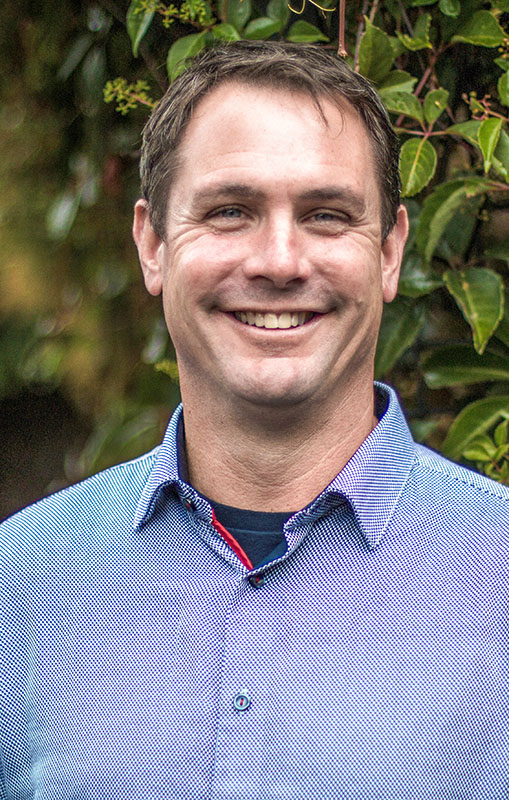
Scott Holsapple, principal, SHD Landscape Architecture www.shd-la.com
Can you trace your interest in landscape architecture and design back to a particular influence?
Living aboard a sailboat as a child drove me toward terra firma, a yearning for dry land. My mother loved to garden and my father loved to hike and camp which had a profound influence. This marriage eventually led me to Landscape Architecture and the foolish notion that I could create a space as unintentional as nature, which has since been at the heart of my design. I know I’ll never achieve this, but I keep trying.
You have experience designing public, commercial and custom residential projects. Does one area of design inform the other?
The real joy of design comes from watching people and animals enjoy a space I created. Public work provides that while custom residential work yields wonderful personal interactions and unlimited freedom in design.
How does your strong connection to this region and to nature impact your work?
The most pristine and perfect spaces I’ve ever witnessed are deep in the Cascade and Olympic Mountains. I cannot understand how something so beautiful could exist. Every flower, every needle, every pool of water so perfectly, randomly and unintentionally placed. Everything perfectly balanced.
You have knowledge of horticulture, emerging technologies for sustainable and low-impact development, critical areas design and permitting, current stormwater practices and landscape construction. Share how this influences your designs.
We take our cues from nature, whether that be a natural or built environment. After all, the built environment we live in was perfectly natural not that long ago. All of our specialties are in recognition of this and their tools utilized to maintain some balance.
How do you like to work with your design clients?
I really enjoy sharing our profession, what we do and the collaborative process. Our initial conversations are important as they point us in the right direction for design. Understanding genre is one thing, but distilling the feeling of the space we are trying to create is everything. We don’t have a particular style or lane; we just listen and make client dreams come true.
What is your problem-solving process like with homeowners who have a landscape that doesn’t serve their needs?
Identifying what someone doesn’t like is just as important as discovering what they love. We have in-depth conversations and provide a collage of inspirational garden images to both rule out and get us on the same page aesthetically.
You’ve built up a notable body of residential work. What are some major takeaways from designing landscapes?
Designing landscapes in the Pacific Northwest is wonderfully complex. It is a stroke of luck to be surrounded by environmentally sensitive areas, varied topography and such natural beauty. We are spoiled by the shared landscape and the interesting gardens that are informed by the complexity of site conditions, aligning perfectly with our philosophy of taking our cues from nature. This diversity allows us to keep doing something different and unique, keeping us on our toes.
Describe your design style or philosophy.
We are practiced in many different genres or design styles. Our philosophy is to listen to our client, understand the site and design accordingly.
Best materials to splurge on?
Gardens evolve, so good bones are most important. Proper site preparation makes for a beautiful garden, forever.


